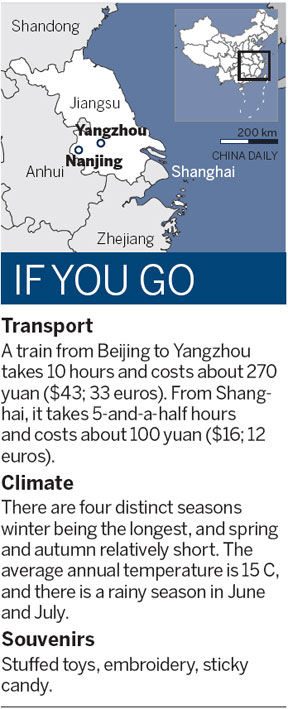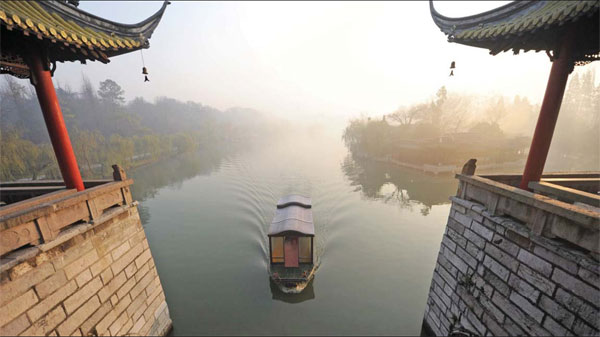Pretty as a picture
Updated: 2013-03-15 07:57
(China Daily)
|
||||||||
|
Five Pavilion Bridge at Slender West Lake in early spring. Provided to China Daily |
Yangzhou has long been a destination for travelers seeking beauty, and today it attracts tourists looking for a well-preserved taste of the country's past
Departing friends are a constant theme of Chinese poets down the centuries, and one of the best known passages on the matter is by Li Bai more than 1,200 years ago: "In the firework-like lunar March, an old friend has just bid farewell to the Yellow Crane Tower and is about to set off for the city of Yangzhou."
The lines are about the departure of his friend and fellow poet Meng Haoran, and have inspired his contemporaries in the Tang Dynasty (AD 618-907) and countless travelers since to seek out the beauty of Yangzhou.
Visitors today are astonished by how well preserved the ancient city is and by its resemblance to the scenery in traditional Chinese paintings, with rolling hills, winding rivers, flowers, birds, pavilions and towers.
Some of the city's main attractions:
1. Dongguan Street
Dongguan Street has existed since the Tang Dynasty. Today, with more than 20 historical sites packed into the area, along with 10,000 residents, the 1.1-km street and surrounding area is the most stylish part of Yangzhou.
More than 100 lanes wind through the area past traditional architecture that throws the visitor back in time.
2. Geyuan and Heyuan gardens

The traditional Chinese garden was designed to present an ideal way of living, connecting man and nature. Geyuan and Heyuan gardens are outstanding examples of this, with water and greenery taking up a large part of every section, each serving a particular purpose.
Geyuan's history stretches back 190 years, yet it feels as fresh as the bamboo shoots planted there.
The garden is landscaped to reflect the four seasons, making it an excellent place to reflect on life and the passing of time.
Most of the pillars of the garden's main hall are made from Phoebe zhennan, a species of tree that grows up to 30 meters tall, and most of the furniture is round, representing unity.
The western section of the garden was originally the living area and is adorned with delicate decorations that are worth a close look.
There are three sections of man-made hills, named after summer, autumn and winter. Stones were used to create the hills in colors that are typical of each season, the aim being to evoke feelings of passing time.
In Heyuan Garden, Western elements were used, including tree seeds from North America.
The walls are a masterpiece, built high enough to guarantee privacy, but with built-in artificial hills to provide something to look at.
The western wall is the highlight, with its hills and a lake.
The most curious object in the garden is a "magic mirror', which from any angle reflects a scene of beauty. Opposite the mirror lies a pond that on a clear night reflects the moon. The two were placed close together so people would think about reflections and reality.
3. Slender West Lake
Smaller than West Lake in Hangzhou and less well known this lake is not devoid of its own special attractions.
Sitting on the northern bank of Yangtze River, it may seem to be a water attraction typical of the south at first, but it brings together elements from the country's north and south.
The Lotus Flower Pagoda in the lake park is similar to the one in Beihai Park, Beijing. It was rebuilt in 1784 by a wealthy local merchant named Jiang Chun. Legends say he also had a paper pagoda built overnight to flatter Emperor Qianlong, who had suggested adding another pagoda to the park.
At the lake's narrowest point is the Five Pavilion Bridge. The pavilions, with their striking yellow roofs supported on sturdy red columns, are in a style typical of southern design. Mao Yisheng, an expert on bridge building, is once reported to have said: "Among all bridges throughout the nation, Anji Bridge in Hebei province is the oldest, Marco Polo Bridge in Beijing the grandest and the Five Pavilion Bridge the most artistic."
Other tourist attractions in the park include a fishing platform, from which Emperor Qianlong is said to have fished, and several ancient bridges.
China Daily
(China Daily 03/15/2013 page22)

 Li Na on Time cover, makes influential 100 list
Li Na on Time cover, makes influential 100 list
 FBI releases photos of 2 Boston bombings suspects
FBI releases photos of 2 Boston bombings suspects
 World's wackiest hairstyles
World's wackiest hairstyles
 Sandstorms strike Northwest China
Sandstorms strike Northwest China
 Never-seen photos of Madonna on display
Never-seen photos of Madonna on display
 H7N9 outbreak linked to waterfowl migration
H7N9 outbreak linked to waterfowl migration
 Dozens feared dead in Texas plant blast
Dozens feared dead in Texas plant blast
 Venezuelan court rules out manual votes counting
Venezuelan court rules out manual votes counting
Most Viewed
Editor's Picks

|

|

|

|

|

|
Today's Top News
Boston bombing suspect reported cornered on boat
7.0-magnitude quake hits Sichuan
Cross-talk artist helps to spread the word
'Green' awareness levels drop in Beijing
Palace Museum spruces up
First couple on Time's list of most influential
H7N9 flu transmission studied
Trading channels 'need to broaden'
US Weekly

|

|








